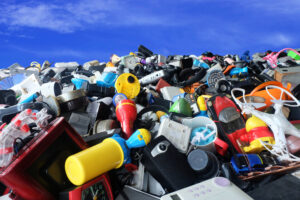
Researchers develop new technique for turning plastic waste into valuable chemicals
Canadian Plastics
Recycling Research & DevelopmentScientists at UC Santa Barbara have created a low-temperature catalytic method that upcycles polyethylene into high-value alkylaromatic molecules that are the basis of many industrial chemicals and consumer products.

Photo Credit: damrong/Adobe Stock
In a development that could make plastic waste recycling more attractive and practical, researchers at UC Santa Barbara in Santa Barbara, Calif., have created a one-pot, low-temperature catalytic method that upcycles PE — a polymer that’s found in about a third of all plastics produced, with a global value of about US$200 billion annually — into high-value alkylaromatic molecules that are the basis of many industrial chemicals and consumer products.
The problem to be solved is that plastic is often cheaper and easier to throw away than it is to recycle. Products made from recycled plastics often possess inferior properties to newly made ones, and breaking plastics down to their original building blocks is often complex and requires a lot of energy or chemicals, so the resulting products often don’t recoup the costs of processing.
A way around this economic hurdle is to “upcycle” plastic waste by converting it into valuable chemicals. However, this often involves the energy-intensive, laborious step of breaking the plastic down to its basic components before synthesizing the desired compounds.
Lead researcher Susannah Scott, a chemical ngineer at the UC Santa Barbara, and her colleagues have developed a simple, low-energy technique for converting PE into alkylaromatic compounds – and successfully tested their method on actual PE waste consisting of a plastic bag and a water bottle cap.
The research team’s new method relies on two different chemical reactions that operate in tandem. One uses hydrogen to cut PE apart into smaller pieces, breaking the strong molecular bonds holding the plastic together; the other synthesizes alkylaromatic compounds. The latter reaction generates hydrogen that can help drive the former reaction. Only a small quantity of by-products is created – light gases such as methane, which can be burned to help provide energy to run the process.
The development employs a new tandem catalytic method that not only creates high-value alkylaromatic molecules directly from waste PE plastic, it does so efficiently, at low cost and with a low energy requirement.
“We brought the temperature of the transformation down by hundreds of degrees,” Scott said. Conventional methods require temperatures between 500 and 1,000°C to break down the polyolefin chains into small pieces and reassemble them into a mixture product of gas, liquid and coke, she said, while the optimal temperature for this catalytic process hovers in the neighborhood of 300°C. The relatively mild reaction condition helps break down polymers in a more selective way to a majority of larger molecules within a lubricant range, the researchers explained. “And we simplified the number of steps in the process because we’re not doing multiple transformations,” Scott said.
In addition, the process requires no solvent or added hydrogen, just a platinum on alumina (Pt/Al2O3) catalyst for a tandem reaction that both breaks those tough carbon-carbon bonds, and rearranges the polymer’s molecular “skeleton” to form structures with those characteristic six-sided rings — high-value alkylaromatic molecules that find widespread use in solvents, paints, lubricants, detergents, pharmaceuticals and many other industrial and consumer products.
Future research could not only explore ways to make this catalyst more effective, but also investigate different catalysts that can break down other plastics or generate other valuable products, Scott said.
Source: UC Santa Barbara
